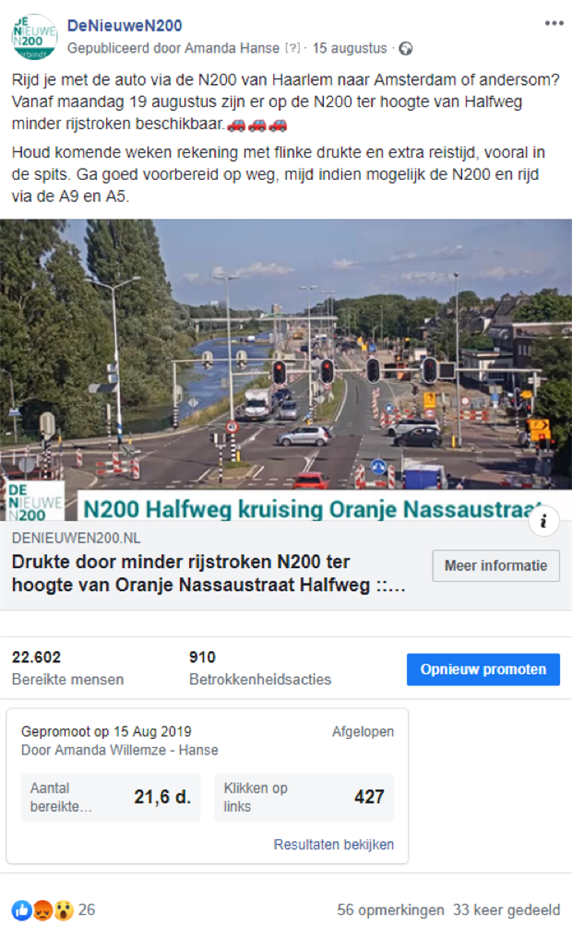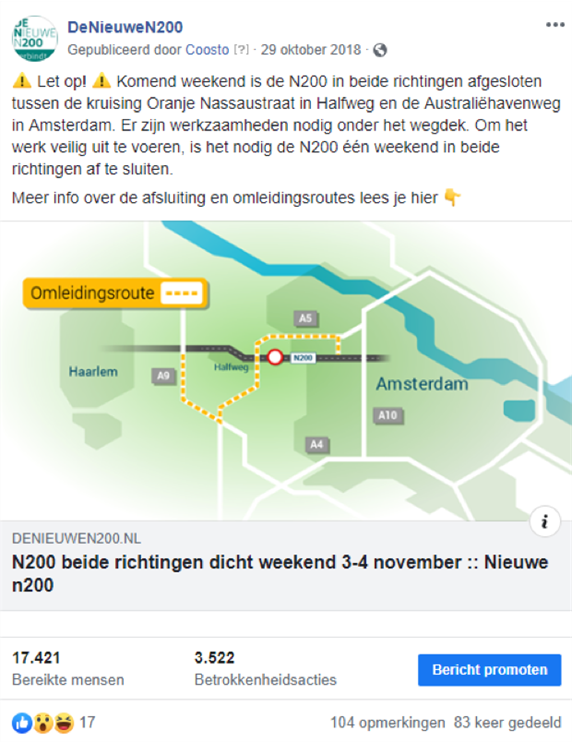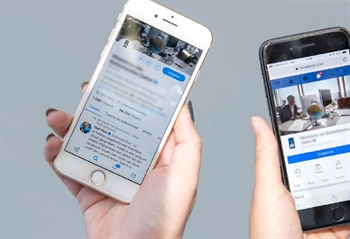Case study Targeted travel information via social media with The New N200
The N200 is undergoing a major refurbishment between Halfweg and Amsterdam. More than 40 phases were planned in 2019 alone. This, in combination with the location of the national highway in a densely populated area with a variety of target groups, presents a considerable challenge in the field of communication, and traffic and mobility management. In order to inform N200 users about closures on time, one of the channels the project uses is social media.
To motivate road users to make smart travel choices, early information is important. The project does this by means of an extensive communication and social media campaign, in-app notifications, cameras that show the current traffic volume and yellow information signs and trailer-mounted VMSes beside the road. The project uses social media because many people use these channels. With the use of advertising and geofenced targeting, the project can address the N200 road user quickly and very specifically.
The project
The New N200 (De Nieuwe N200) is active on Facebook, Instagram and Twitter. On Facebook, @denieuwen200 has 2,800 followers with whom the project shares weekly reports about activities, closures and disruptions. In addition, local residents and road users can contact @denieuwen200 with questions or reports.
The environmental team uses social media advertising to bring information about local closures to the attention of specific groups or neighbourhoods. To do this, the team uses Facebook's advertising tool to reach people who are unfamiliar with the channels and community of The New N200. In order to reach people who regularly drive on the N200 but do not come from the surrounding area (and therefore do not quickly hear about the project via other channels), the project also uses geofenced targeting (a virtual 'fence on the road').
Implementation
Anyone with Facebook can post advertisements By creating target groups and promoting messages to people in these target groups, Facebook's algorithm pushes the message 'up' on their timeline. Target groups can be selected according to location, demography and interests. The New N200 uses this to reach people in surrounding neighbourhoods with information about closures, for example of a local side road.
Whether the team promotes a message is often decided shortly in advance. This depends on the impact of the closure and the organic (unpaid) range of a message. If the unpaid reach is low, the project may decide to boost attention for a particular target group. The amount paid for the advertisement is based on factors such as the size of the target group, the content and the type of message. The Facebook advertising tool provides tailor-made advice and shows the estimated paid reach for the amount to be used.
The Facebook advertising tool has limitations in terms of location targeting: you cannot select target groups that drive along a certain road. This is why the project uses geofenced targeting in the case of large closures with an impact on through traffic. This allows you to detect social media accounts that arrive at a specific location. The data from this forms a new target group in which specific messages about closures can be boosted. By addressing (paid) road users who drive on the road, there is a good chance that they will perceive the information as relevant and disseminate it (by liking, sharing, or reacting). That's how the reach grows. The New N200 works with a premium Facebook developer for geofenced targeting. This method is GDPR-compliant.

Result
In The New N200, geofenced targeting has not yet been used much, which means that there are few concrete results. One of the geofenced targeted messages was shared and liked so much that it reached over 17,000 people on Facebook, almost 15 times as many as the 1,200 followers at the time. This result does show a difference with unpromoted messages. The Facebook algorithm often shows unpaid messages only to some of the followers of an account. Promoted messages reach more people (including people who do not know the page), and thus have a higher reach than messages with only organic reach.
Because the geofence has only been applied once, there is still little to say about the effect of the advertising and geofencing in combination or separately. There has been no major congestion on the N200 since the start of implementation in 2018. Whether the use of targeted messages actually causes road users to make different travel choices is not yet clear. However, it is likely that the extensive accessibility measures package for The New N200, of which social media advertising is a part, will make an important contribution to reducing disruption on the N200.

Considerations for deployment elsewhere
Advertising and geofenced targeting have been used in the advertising world for many years, but their application is quite new in the field of mobility. On roads where little is known about road users, geofenced targeting in particular can pay off. The following considerations apply to the use of advertising and geofenced targeting:
- Think about why you want to use social media advertising and/or geofenced targeting. It is a handy tool, but not a panacea. Whether deployment is useful depends on your task and communication goals.
- Ensure you have sufficient knowledge of social media. The choice of platforms, target groups, content and scheduling are important for the success of your approach.
- The algorithms of social media platforms reward good content and a message that fits your target groups. They give this content more attention and thus ensure a greater reach. Make sure your message is relevant to the target group and preferably make it appealing. Otherwise, geofence advertising will not work either.
- Make good agreements about what you expect in terms of results and monitoring. By doing this, you can draw firm conclusions and know whether the effort via social media has had the desired result.
- Use an existing community. Preferably, use the measure in a project that already has a social media community.
In this way you not only have paid advertisements but also organic reach.

